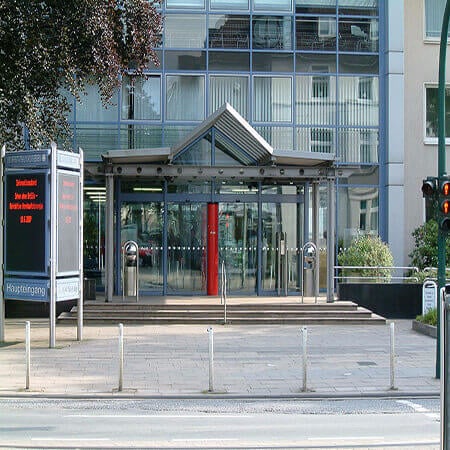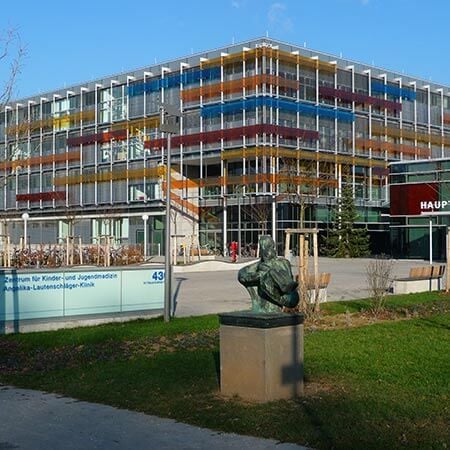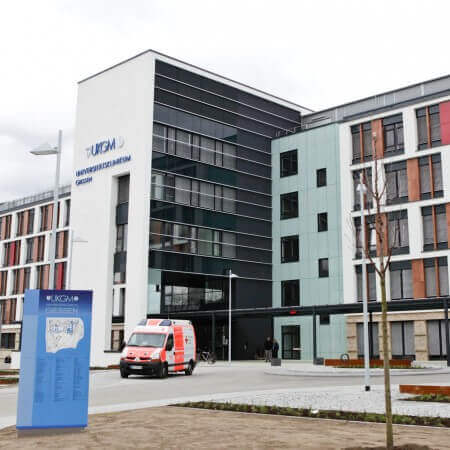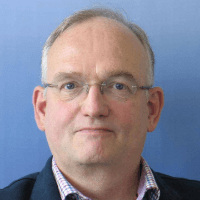Chondrosarcoma — Proton Therapy: treatment in the Best Hospitals in the World
Treatment prices are regulated by national law of the corresponding countries, but can also include additional hospital coefficients. In order to receive the individual cost calculation, please send us the request and medical records.

Department of Adult and Pediatric Proton Therapy
The Department of Adult and Pediatric Proton Therapy offers the full range of proton treatment and it is one of the leading and most progressive medical facilities of this kind not only in Germany, but throughout the world. The proton therapy is mostly used for the treatment of tumors of the eye, brain, spine and pelvic organs. Also, the proton therapy is an excellent treatment of tumors in children, since it has a minimal negative effect on the immature, sensitive tissues of the child’s body.







National Center for Tumor Diseases (NCT) Heidelberg
The National Center for Tumor Diseases (NCT) Heidelberg offers the full range of diagnostics and treatment of various oncological diseases. Since its foundation in 2004, the center has gained a reputation of one of the leading in Germany. The center is supported by the German Cancer Research Center (DKFZ) and the German Cancer Aid (Deutschen Krebshilfe). The center treats about 60,000 patients from 45 countries every year. Thanks to the outstanding research activities, the department has the very latest therapeutic opportunities that save lives for thousands of people.


Proton Therapy Center
The Proton Therapy Center specializes in an innovative type of radiation therapy for children, namely proton therapy. The medical facility is one of four centers in Germany offering proton therapy for cancer treatment in young patients. The center has been working since October 2015 in close cooperation with the Marburg Ion Beam Therapy Center and today can boast exceptional clinical experience in the field of its competence. Proton therapy is significantly superior to conventional radiation therapy in terms of dose control, dose distribution and side effect profile. Thus, it is an excellent alternative form of cancer treatment. The main advantage of proton therapy is that it has potentially fewer immediate and long-term side effects as compared to classical radiation therapy. The harmful effects on healthy tissues during proton therapy are minimized, which is especially important for children, as their brain and body are in the growth phase. In addition, proton therapy is provided on an outpatient basis and is an absolutely painless treatment, which is also important for young patients.

Chondrosarcoma is a rare tumor that can develop at the base of the skull. In such cases, its irradiation using conventional methods is unsafe for a patient. Thus, proton therapy is preferred, because it delivers radiation very accurately, with minimal risk of damage to the cranial nerves or brainstem.
Not every country uses proton therapy. If this method of treatment is not yet used in your country, you should go to Europe. In developed countries, there are specialized proton therapy centers with state-of-the-art equipment. They use pencil beam scanning technology, which allows irradiating the chondrosarcoma even more accurately and safely.
Content
- What is chondrosarcoma
- When is proton therapy required
- What is proton therapy
- Strategies for proton radiation therapy application
- Patient survival
- Why is it worth undergoing cancer treatment abroad
- Treatment in Europe with Booking Health
What is chondrosarcoma
Chondrosarcoma is one of the main types of bone sarcomas in adolescents. But still, most of the pathology cases occur at the age of 30-60 years. Most neoplasms are low grade tumors.
Chondrosarcoma most often develops on the limbs, less often on flat bones (scapula, pelvis, ribs). Nevertheless, it can appear in any other place, including those inconvenient for surgical removal and radiation: spine, skull, larynx, trachea.
The main treatment option for chondrosarcoma in medicine is surgical removal of the tumor, including cryoablation. Radiation therapy for chondrosarcoma may be used to reduce the risk of recurrence. Sometimes irradiation can be used without surgery.
When is proton therapy required
Approximately 10% of chondrosarcomas are localized at the base of the skull. They cannot be safely removed. Standard radiation therapy for these patients is also associated with a greater risk of complications.
As a rule, the patients with tumors of the base of the skull are young, up to 40 years old. They often have symptoms of compression of the brainstem or cranial nerves. Chondrosarcoma rarely spreads metastasis. However, it shows a high level of local aggression and often recurs after removal.
With chondrosarcoma of the base of the skull, doctors prefer to perform surgery in only 30% of patients. For the rest, they use non-surgical treatment options, mainly radiation. But even in those patients treated with surgery to remove chondrosarcoma, the risk of recurrence reaches 22%. Therefore, they need radiation therapy after the surgical intervention.
The brainstem is usually located near the chondrosarcoma of the base of the skull, the irradiation of which can lead to the death of the patient, and the visual apparatus – too much radiation on the surrounding tissues often leads to a significant vision impairment or blindness. Therefore, in radiation oncology, proton beams are considered the main method of irradiation of skull base tumors, but not photons, which are usually used for other types of cancer.
What is proton therapy
Many methods have already been developed in medicine for delivering radiation to malignant neoplasms. In the twentieth century, gamma therapy was used predominantly. In the twenty-first century, in developed countries, it was completely replaced by photon radiation therapy carried out with the help of linear accelerators.
Today, it is photons that are used as the main source of radiation for tele-irradiation of tumors. Modern methods of radiation therapy are highly safe. The beams are directed at the tumor very precisely, and are injected from different sides, so that at each site the dose of radiation to healthy tissues is minimal. At the same time, all beams converge on the tumor, thereby ensuring the destruction of cancer cells.
However, for all the advantages of photon radiation therapy, it is far from perfect. The problem with photons is that they release radiation not only inside the tumor, but also along the way to it. As a result, healthy tissues are inevitably damaged – the more, the deeper the neoplasm is located in the human body.
The patients undergoing photon therapy can suffer severe complications if they are treated for tumors of the base of the skull. Therefore, protons are preferred in such situations. They release most of the energy only inside the tumor. On the way to it, radiation is almost not emitted. Behind the target (by the release of protons from the tumor), the energy is rapidly extinguished, and the tissues located behind are not irradiated at all.
The key benefits of protons are as follows:
- Minimum radiation for healthy tissues, and therefore the risk of complications is lower.
- Uniform distribution of the radiation dose, and therefore treatment regimens with a small number of fractions can be used (irradiation in fewer sessions).
- Possibility to deliver higher doses of radiation to the target in order to overcome the radioresistance of the tumor.
Strategies for proton radiation therapy application
In medicine, proton beams for irradiation of cancer can be used in different situations: as an independent method of treatment, as an adjuvant treatment after surgery, or to suppress the recurrence of pathology.
In oncology, doctors use different approaches to proton therapy for chondrosarcoma. The following options are possible:
- Tumor removal followed by immediate proton therapy. This is the preferred option. The resection of the neoplasm, especially if the cancer has been removed completely, provides the best survival rates. When localized at the base of the skull, it is often possible to remove the chondrosarcoma only partially. In this case, proton irradiation plays a significant role in preventing relapse, which occurs in 30-40% of cases without adjuvant therapy.
- Tumor removal without irradiating the residual tumor with protons. The patient is then monitored. If a relapse is detected, the cancer is suppressed by radiation. This approach is used less often in oncology. It is mainly used in young patients to reduce the risk of complications. A refusal of immediate irradiation is possible in cases where the doctor has been able to perform total resection of the cancer.
- Proton therapy without surgery. In case of the chondrosarcoma of the base of the skull, this is the most common option. In 70% of cases, surgical resection is not possible. Photon radiation therapy often causes complications. Therefore, in developed countries, protons are almost always used to irradiate cancer in such patients. The treatment outcomes depend on the size of the chondrosarcoma. The disease can usually be cured if the cancer does not exceed 25 cubic centimeters in volume. With a larger volume, the likelihood of cure decreases.
Patient survival
A study by the Paul Scherrer Institute (Switzerland) gives the following results of tumor control within 8 years after proton irradiation:
- With a volume of up to 25 cubic centimeters, in 97% of cases the tumor did not recur.
- With a volume of more than 25 cubic centimeters, local control was retained in 68.4% of cases.
Tumor volume also correlates with treatment toxicity. With a smaller size, only half of the patients suffered from grade 3 or higher side effects. Nevertheless, toxicity as a result of proton irradiation was recorded in 85% of patients undergoing therapy for tumors of more than 25 cubic centimeters.
When determining the total dose of radiation for cancer treatment, doctors must find a balance: on the one hand, to minimize the risk of recurrence, on the other, to reduce the likelihood of side effects. With irradiation with a dose of 70 Gy, the recurrence rate of cancer during 8 years of observation is lower: only 5.8%. However, 80% of patients develop toxicity of grade 3 or more. When using a dose of less than 70 Gy, the risk of recurrence reaches 12.6%, but only one in three patients develops toxicity.
Why is it worth undergoing cancer treatment abroad
Protons are being increasingly used instead of photons to treat diseases in oncology. Developed countries can offer dozens of proton therapy centers. Movable gantries have appeared that can deliver proton beams to any part of the patient's body. The new active pencil beam technology is being increasingly used instead of passive scattering technology. It makes it possible to successfully and even more safely perform proton radiation therapy even for tumors of complex configuration. By modulating the intensity, minimal damage to the tissues surrounding the tumor can be achieved.
Thousands of patients travel to Europe for cancer treatment. Doctors abroad use the latest techniques in oncology, which are safer and more effective. There are several reasons for you to undergo proton therapy in one of the developed countries:
- The experience in the treatment of chondrosarcoma is counted in tens of years. This is one of the first diseases in which doctors began to use protons.
- The use of intensity modulated proton therapy, which is even safer and less likely to cause post-radiation complications.
- It is possible to successfully irradiate even large neoplasms with the size of more than 25 cubic centimeters.
- Successful proton therapy in different situations: as a radical treatment (without surgery), as an adjuvant treatment (after surgery).
- Extensive experience in the use of protons for relapses of the disease.
- Safe irradiation even in conditions of compression of the brainstem and cranial nerves.
- Successful combination of proton therapy with other cancer treatment options.
In European countries, not only new technologies are waiting for you, but also comfort, quality care, timely and adequate assistance in case of complications.
Proton therapy is more expensive than photon therapy. For many patients, one of the key selection criteria is the cost of treatment. On our website, you can compare the cost of services in different hospitals in the world. Even in Western Europe, proton therapy is cheaper than in Japan and North America. In Eastern Europe, prices are lower than in Western Europe, although the advanced cancer centers specializing in proton therapy in Russia and the Czech Republic use the most modern technologies.
Treatment in Europe with Booking Health
To undergo proton beam therapy in one of the European hospitals, please use the services of the Booking Health company. On our website, you can find out the cost of treatment in different hospitals, compare prices and book a medical care program at a favorable price. Proton radiation therapy in a European hospital will be easier and faster for you, and the cost of treatment will be lower.
Please leave your request on the Booking Health website. Our employee will contact you and provide a consultation about treatment in Europe. The Booking Health company will take care of the organization of your trip. We will provide the following benefits for you:
- We will select the most suitable hospital for treatment in Europe, whose doctors have significant experience in using proton therapy in the treatment of chondrosarcoma.
- We will solve the problem of the language barrier, establish communication with your attending physician.
- We will reduce the waiting time for the start of the medical care program and book a doctor's appointment on the most suitable dates.
- We will help to reduce the price. The cost of treatment in European hospitals will be lower due to the lack of additional coefficients for foreign patients.
- We will take care of any organizational issues: documents for entering the country, transfer from the airport, hotel, interpreting services, etc.
- We will prepare a program and translate medical documents. You will not need to repeat the previously performed diagnostic procedures.
- We will provide communication with the cancer center after treatment in Europe.
- We will organize additional diagnostic examinations and treatment in a European hospital, if necessary.
- We will buy medicines abroad and forward them to your native country.
- We will help you keep in touch with the hospital and the doctor after treatment in Europe.
You will receive treatment from the best doctors in the world. The Booking Health employees will help reduce the cost of treatment and take care of all organizational issues, and you will only have to focus on restoring your health.
Authors: Dr. Nadezhda Ivanisova, Dr. Sergey Pashchenko

